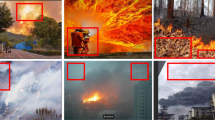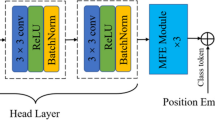Abstract
Fire detection and alarm system is fully concerned for safety. And convolutional neural network (CNN) has been introduced into fire/smoke detection based on video/image understanding. However, the samples of the existed public fire/smoke data sets are not enough to train very deep CNN. And the generalization abilities of the existed methods are limited. Therefore, a fire monitoring and alarm system (FMAS) based on channel-wise pruned YOLOv3 is proposed, and a big fire and smoke image data set has been collected in this paper. YOLOv3 with Darknet-53 is deep and its generalization ability has been demonstrated in general objects detection. But it has massive parameters, which may hinder its applications in fire monitoring systems with restricted computation resources. Thus, channel-wise pruning technology is introduced to reduce the number of parameters while bringing a slight drop of accuracy. Moreover, OHEM technology is proposed to improve the detection accuracy further. Multiple comparison experiments on the homemade data set and the public data sets have demonstrated that the proposed channel-wise pruned YOLOv3 with OHEM can achieve satisfactory accuracy with low calculation capacity after squeezing parameters.









Similar content being viewed by others
References
ByoungChul K, Kwak JY, Nam JY (2012) Wildfire smoke detection using temporospatial features and random forest classifiers. Opt Eng 51(1):7208
Byoungjun K, Joonwhoan L (2019) A video-based fire detection using deep learning models. Appl Sci 9(14):2862
Celik T, Demirel H (2008) Fire detection in video sequences using a generic color model. Fire Safety 44(2):147–158
Chen TH, Wu PH, Chiou YC (2004) An early fire-detection method based on image processing. In: 2004 International conference on image processing, vol 3, pp 1707–1710
Christian H, Willi S (2019) Exploration of the variability of variable selection based on distances between bootstrap sample results. ADAC 13(4):933–963
Foggia P, Saggese A, Vento M (2015) Real-time fire detection for video-surveillance applications using a combination of experts based on color, shape, and motion. IEEE Trans Circuits Syst Video Technol 25(9):1545–1556
Frankle J, Carbin M (2018) The lottery ticket hypothesis: Training pruned neural networks. In: 6th International conference on learning representations, Vancouver Convention Center, Vancouver CANAD, pp 1–42
Girshick R, Donahue J et al (2014) Rich feature hierarchies for accurate object detection and semantic segmentation. In: 2014 IEEE Conference on computer vision and pattern recognition, pp 580–587
Habiboglu YH, Gunay O, Cetin AE (2012) Covariance matrix-based fire and flame detection method in video. Mach Vis Appl 23(6):1103–1113
Han C, Gao G, Zhang Y (2019) Real-time small traffic sign detection with revised faster-RCNN. Multimed Tools Appl 78(10):13263–13278
Hu X (2013) Research and product development of MIR flame detector system. J Zhejiang Univ 10(1):78
Hu H, Peng R et al (2017) Network trimming: A data-driven neuron pruning approach towards efficient deep architectures. In: 5th International conference on learning representations, Palais des Congres Neptune, Toulon, France, pp 1–9
Hu C, Tang P et al (2018) Real-time fire detection based on deep convolutional long-recurrent networks and optical flow method. In: 2018 37th Chinese control conference(CCC), Wuhan, pp 9061–9066
Huang YW (2015) Dynamic cost-sensitive ensemble classification based on extreme learning machine for mining imbalanced massive data streams, vol 8
Iandola FN, Han S et al (2017) SqueezeNet: AlexNet-level accuracy with 50x fewer parameters and < 0.5 MB model size. In: 5th International conference on learning representations, Palais des Congres Neptune, Toulon, France, pp 1–13
Ioffe S, Szededy C (2015) Batch normalization: Accelerating deep network training by reducing internal Covariate Shift, Lille, France International Conference on Machine Learning 1–11
Javad H, Somaye M (2019) Identification of uncertainty and decision boundary for SVM classification training using belief function. Appl Intell 49 (6):2030–2045
Jiao Z (2019) Research on UAV system for forest fire prevention, Xi’an Xi’an Technological University
Joshi MV, Kumar V, Agarwal RC (2001) Evaluating boosting algorithms to classify rare classes: comparison and improvements. In: Proceedings - IEEE international conference on data mining, pp 257–264
Kolesov I, Karasev P et al (2010) Fire and smoke detection in video with optimal mass transport based optical flow and neural networks. In: 2010 IEEE International conference on image processing, Hong Kong, pp 761–764
Lascio RD, Greco A et al (2014) Improving fire detection reliability by a combination of videoanalytics, vol 3, pp 477–484
Lebedev V, Lempitsky V (2016) Fast convnets using group-wise brain damage. In: 2016 IEEE conference on computer vision and pattern recognition (CVPR), pp 2554–2564
Li H, Kadav A et al (2017) Pruning Filters for Efficient ConvNets. In: 5th International conference on learning representations, Palais des Congres Neptune, Toulon, France, pp 1–13
Lin TY et al (2017) Focal loss for dense object detection, IEEE Trans Pattern Anal Mach Intell. 2999–3007
Liu W, Anguelov D, Erhan D (2016) SSD: Single Shot MultiBox Detector. In: European conference on computer vision, 21–37
Liu Z, Li J et al (2017) Learning efficient convolutional networks through network slimming. In: IEEE International conference on computer vision, pp.2755–2763
Lu X, Ma C et al (2018) Deep regression tracking with shrinkage loss. In: 15th European conference, Munich, Germany, September, pp 8–14
Lu X, Ma C et al (2019) Adaptive region proposal with channel regularization for robust object tracking. In: IEEE Transactions on circuits and systems for video technology
Lu X, Tang F et al (2019) Learning channel-aware deep regression for object tracking. Pattern Recogn Lett 127:103–109
Luo J, Wu J, Lin W (2017) Thinet: A filter level pruning method for deep neural network compression. In: IEEE International conference on computer vision, pp 5068–5076
Mathew J, Luo M, Pang CK (2015) Kernel-based SMOTE for SVM classification of imbalanced datasets. In: IECON 2015-41st Annual conference of the IEEE industrial electronics society, pp 1127–1132
Molchanov P, Tyree S et al (2017) Pruning convolutional neural networks for resource efficient inference. In: 5th International conference on learning representations, Palais des Congres Neptune, Toulon, France, pp 1–17
Muhammad K, Ahmad J et al (2019) Efficient deep CNN-based fire detection and localization in video surveillance applications. IEEE Trans Syst Man Cybern Syst 19(7):1419–1434
Namozov A, Cho YI (2018) An efficient deep learning algorithm for fire and smoke detection with limited data. Adv Electr Comput Eng 18(4):121–128
Rafiee A, Dianat R et al (2011) Fire and smoke detection using wavelet analysis and disorder characteristics. In: 2011 3rd International conference on computer research and development, vol 3, pp 262–265
Redmon J, Divvala S, Girshick R (2016) You only look once: Unified real-time object detection. In: 2016 IEEE Conference on computer vision and pattern recognition (CVPR), 779–788
Redmon J, Farhadi A (2017) YOLO9000: Better, faster, stronger. In: 2017 IEEE Conference on computer vision and pattern recognition (CVPR), pp 6517–6525
Redmon J, Farhadi A (2018) YOLOv3: An incremental improvement, university of washington eprint. In: IEEE Conference on computer vision and pattern recognition, pp 6517–6525
Shafiee MJ, Chywl B et al (2017) Fast YOLO: A fast you only look once system for real-time embedded object detection in video. J Comput Vis Imag Syst 3:7208
Shen D, Chen X, Yan W (2018) Flame detection using deep learning. In: Proceedings of the 2018 4th international conference on control automation and robotics, pp 416–420
Shi F, Qian H et al (2020) A fire monitoring and alarm system based on YOLOv3 with OHEM. In: The 39th Chinese control conference, Shenyang Royal Wanxin Hotel, Shenyang, China, pp 7322–7327
Shi F, Qiu Z et al (2020) An improved alogorithm of faster R-CNN based on variable weight loss function and OHEM. Comput Modern 8:56–62
Shrivastava A, Gupta A, Girshick R (2016) Training region-based object detectors with online hard example mining. In: Conference on computer vision and pattern recognition, pp 761–769
Simonyan K, Zisserman A (2015) Very deep convolutional networks for large-scale image recognition. In: 3rd International conference on learning representations, San Diego, CA, USA, pp 1–14
Wan Z (2020) Fire detection from images based on single shot multibox detector. Hohai university, Nanjing
Wang K, Wang J et al (2019) Defect detection of pins based on RetinaNet and class balanced sampling methods. Elect Power Eng Technol 38(4):80–85
Wang Z, Wohlwend J et al (2020) Structured Pruning of Large Language Models. In: Proceedings of the 2020 conference on empirical methods in natural language processing (EMNLP), pp 6151–6162
Wen W, Wu C et al (2016) Learning structured sparsity in deep neural networks. In: Advances in neural information processing systems, vol 29. Curran Associates Inc, pp 2074–2082
Wu X, Lu X, Leung H (2017) An adaptive threshold deep learning method for fire and smoke detection. In: IEEE Transactions on systems, man and cybernetics, pp 1954–1959
Xu Y, Zhang J et al (2013) The structure of automatic fire alarm system based on virtual instrument. J Tianjin Univ Technol 29(3):30–36
Xu G, Zhang Y et al (2017) Deep domain adaptation based video smoke detection using synthetic smoke images. Fire Safety J 93:53–59
Yu C, Zhang Y et al (2010) Video smoke recognition based on optical flow. In: 2010 2nd International conference on advanced computer control, Shenyang, pp 16–21
Zhang Q, Lin G, Zhang Y (2018) Wildland forest fire smoke detection based on faster R-CNN using synthetic smoke images. Procedia Eng 211:441–446
Zhao Y, Ma J et al (2018) Saliency detection and deep learning-based wildfire identification in UAV imagery. Sensors 18(3):712
Acknowledgements
The research is supported by the Chinese Scholarship Council and the Fundamental Research Funds for the Central Universities, under Grant No. 26120182018B15514.
Author information
Authors and Affiliations
Corresponding author
Additional information
Publisher’s note
Springer Nature remains neutral with regard to jurisdictional claims in published maps and institutional affiliations.
Rights and permissions
About this article
Cite this article
Qian, H., Shi, F., Chen, W. et al. A fire monitoring and alarm system based on channel-wise pruned YOLOv3. Multimed Tools Appl 81, 1833–1851 (2022). https://doi.org/10.1007/s11042-021-11224-0
Received:
Revised:
Accepted:
Published:
Issue Date:
DOI: https://doi.org/10.1007/s11042-021-11224-0




